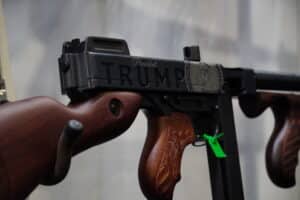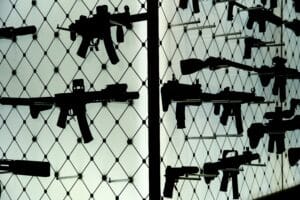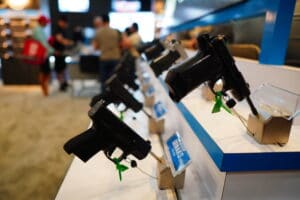Three federal court judges and one appeals panel have now issued injunctions against President Joe Biden’s pistol-brace ban. Worse for him and the ATF, the judges have clarified those injunctions extend to millions of members of a collection of gun-rights groups. However, they don’t extend to everyone.
This is a clear setback for Biden, the brace ban, and his larger effort to enact new gun restrictions through executive actions. But it isn’t a total win for gun-rights activists.
On Wednesday, three different federal courts released orders saying the ATF could not enforce the ban. They enjoined the agency against arresting the named plaintiffs in the case over the rule. The fact that three major gun-rights groups were named plaintiffs in those cases complicated things a bit. At first, it was unclear whether members of the Firearms Policy Coalition (FPC), Second Amendment Foundation (SAF), and Gun Owners of America (GOA) were covered by the injunctions.
FPC and SAF filed motions asking the courts to clarify shortly after the rulings came down, and the courts did. First, a Fifth Circuit panel said its injunction in Mock v. Garland extends to FPC’s members. Then Judge Jane J. Boyle said her injunction extends to SAF members. Immediately after that Judge Drew B. Tipton issued a similar injunction for GOA members. Finally, Judge Matthew Kacsmaryk issued an identical order for Wisconsin Institute for Law & Liberty in Britto v. ATF.
So, where does that leave things?
One fact to notice about all of these injunctions is where they were issued: the Fifth Circuit. That ruling from the three-judge appeals panel is what drove the rest of these rulings. The district court judges were directly and explicitly following the lead of the Fifth Circuit panel as they are supposed to do.
“The Court finds the same relief afforded to the Mock plaintiffs is appropriate for the private Plaintiffs in this case—Gun Owners of America, Inc., Gun Owners Foundation, and Brady Brown,” Judge Tipton wrote in Texas v. ATF. “This is because the motion in Mock and the Motion before this Court are substantially similar. Both motions seek an injunction enjoining enforcement of the Final Rule on the grounds that it violates the Administrative Procedure Act and the Second Amendment. And while the Plaintiffs here raise some arguments that were not raised in Mock, the resolution of that appeal will almost certainly affect, if not control, the Court’s decision on Plaintiffs’ Motion.”
The panel also rejected a request to expand the injunction beyond the plaintiffs named in the suit because it could constitute a nationwide ruling, which several Supreme Court justices have come out against lower courts issuing in recent years.
“Any relief beyond what is explicitly requested, which arguably would be tantamount to a nationwide injunction, is DENIED,” the panel wrote.
So, the district judges followed suit and denied any injunctions that went beyond the named plaintiffs. Similarly, Judge Tipton denied a request to extend the injunction to everyone in the state of Texas.
That means millions of gun owners who are members of the named gun-rights groups are protected from arrest over possession of unregistered pistol-brace-equipped firearms, FPC claims that even includes members who’ve joined after the injunction was issued. But it also means many more millions remain vulnerable.
Nobody knows exactly how many braces have been sold in the decade since the ATF first declared their use didn’t turn a pistol into a short-barrel rifle subject to National Firearms Act (NFA) regulations (before changing its mind last year at the behest of President Joe Biden). The Congression Research Service estimates there are between ten and 40 million of the devices in civilian hands. The ATF puts the number somewhere between three and ten million. So, there’s at least agreement the number reaches into the millions.
The ATF has yet to respond to a request for how many braced guns were registered during the amnesty period that ended on Thursday. But it’s likely that number represents only a small fraction of the total affected by the ban, judging by how poorly previous registration or confiscation efforts have gone in places like New York or New Jersey. That means there are probably scores of Americans with what the ATF now considers an unregistered NFA item, a crime punishable by up to ten years in federal prison.
And, while the injunctions issued this month protect some of the most prominent gun-rights groups, members of the nation’s largest gun group remain at risk. That’s because the Fifth Circuit is not the only place where challenges to the pistol-brace ban have been filed. The National Rifle Association, alongside 25 Republican governors and the largest maker of pistol braces, filed FRAC v. Garland in the Eighth Circuit. The case has been fully briefed, and the plaintiffs asked for similar relief to what those in the Fifth Circuit have received, but no ruling has been handed down to this point.
The Eighth Circuit could rule in the NRA’s favor at any time. But Fifth Circuit was always the most fertile ground for this sort of challenge, which is probably why so many cases were filed there. That’s because the full Fifth Circuit has already struck down a similar executive-branch ban against bump stocks and established a circuit-wide precedent that the ATF can’t bring criminal cases against Americans in situations where they have muddied the interpretation of federal firearms laws by either stretching them to include infractions that aren’t part of the written statute or flip-flopping on how it thinks the statute should apply. That makes claims the ATF violated the Administrative Procedures Act or the rule of lenity with its brace ban easier to digest for Fifth Circuit judges since they can look to the circuit’s ruling in Cargill v. Garland as precedent.
At this pace, the Fifth Circuit may even deliver a ruling on the merits before courts in other circuits weigh in at all. Since the ATF’s deadline for registration of braced guns has now passed without judges in those other circuits getting involved, there aren’t many other key dates that could force their hands coming up anytime soon. Meanwhile, the Fifth Circuit panel has already set an expedited hearing schedule that starts arguments on the merits before the end of the month.
With the panel already agreeing that a preliminary injunction is necessary because the ban is likely unconstitutional, it’s not difficult to forecast the outcome of the case on the merits. But, even if the panel strikes down the ban as unconstitutional and the full court agrees on appeal, the nature of the ruling is likely to remain as limited as the preliminary injunctions have been.
In fact, there’s some reason to think the full court may take issue with including scores of people from all over the country as named plaintiffs by virtue of their purchases from one of the parties in the case.
“One member of the merits panel would not clarify the motion panel’s order to extend the injunction to ‘customers,’” the Fifth Circuit panel wrote in a footnote. “The motion panel’s injunction was limited ‘to the Plaintiffs in this case.’ There is no authority in the motion panel’s order to extend the injunction to an infinite number of non-parties to this case on the theory that, for full relief to be afforded to the plaintiffs, the plaintiffs must be permitted to sell products to an undefined set of downstream purchasers. Full adversary briefing will assist us to confirm our court’s equitable powers under the Constitution.”
Or, even if the Fifth Circuit is alright with that situation, the Supreme Court may not be. Which may elevate the importance of the cases in other circuits even further. Of course, gun-rights advocates would rather be in a situation where the edges of an injunction against the pistol-brace ban are questioned than not have an injunction at all.






